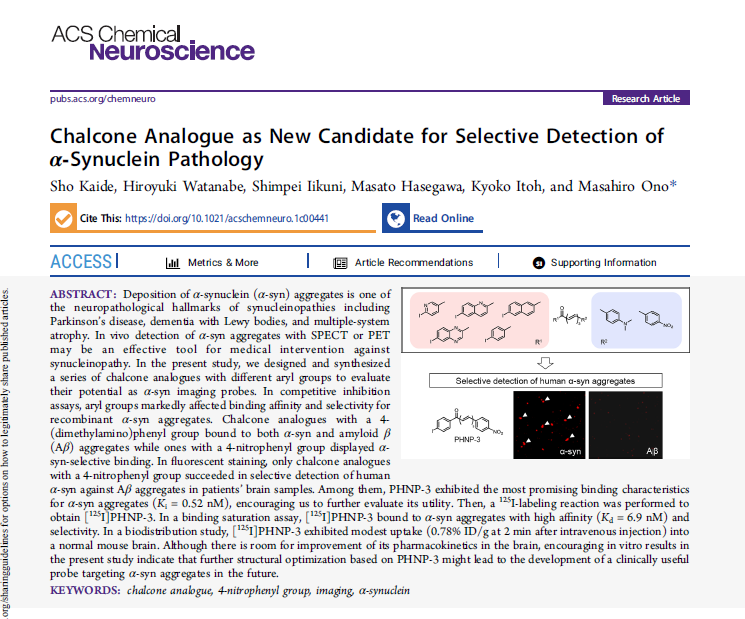Science News
Chalcone Analogue as New Candidate for Selective Detection of α‑Synuclein Pathology
Dic 16, 2021 | News

Deposition of α-synuclein (α-syn) aggregates is one of the neuropathological hallmarks of synucleinopathies including Parkinson’s disease, dementia with Lewy bodies, and multiple-system atrophy. In vivo detection of α-syn aggregates with SPECT or PET may be an effective tool for medical intervention against
synucleinopathy. In the present study, we designed and synthesized a series of chalcone analogues with different aryl groups to evaluate their potential as α-syn imaging probes. In competitive inhibition assays, aryl groups markedly affected binding affinity and selectivity for recombinant α-syn aggregates. Chalcone analogues with a 4- (dimethylamino)phenyl group bound to both α-syn and amyloid β (Aβ) aggregates while ones with a 4-nitrophenyl group displayed α- syn-selective binding. In fluorescent staining, only chalcone analogues with a 4-nitrophenyl group succeeded in selective detection of human α-syn against Aβ aggregates in patients’ brain samples. Among them, PHNP-3 exhibited the most promising binding characteristics for α-syn aggregates (Ki = 0.52 nM), encouraging us to further evaluate its utility. Then, a 125I-labeling reaction was performed to obtain [125I]PHNP-3. In a binding saturation assay, [125I]PHNP-3 bound to α-syn aggregates with high affinity (Kd = 6.9 nM) and selectivity. In a biodistribution study, [125I]PHNP-3 exhibited modest uptake (0.78% ID/g at 2 min after intravenous injection) into a normal mouse brain. Although there is room for improvement of its pharmacokinetics in the brain, encouraging in vitro results in the present study indicate that further structural optimization based on PHNP-3 might lead to the development of a clinically useful probe targeting α-syn aggregates in the future.
https://www.tubintrain.eu/wp-content/uploads/2021/12/16-12-2021-acschemneuro.1c00441.pdf
Written by tubinAD
